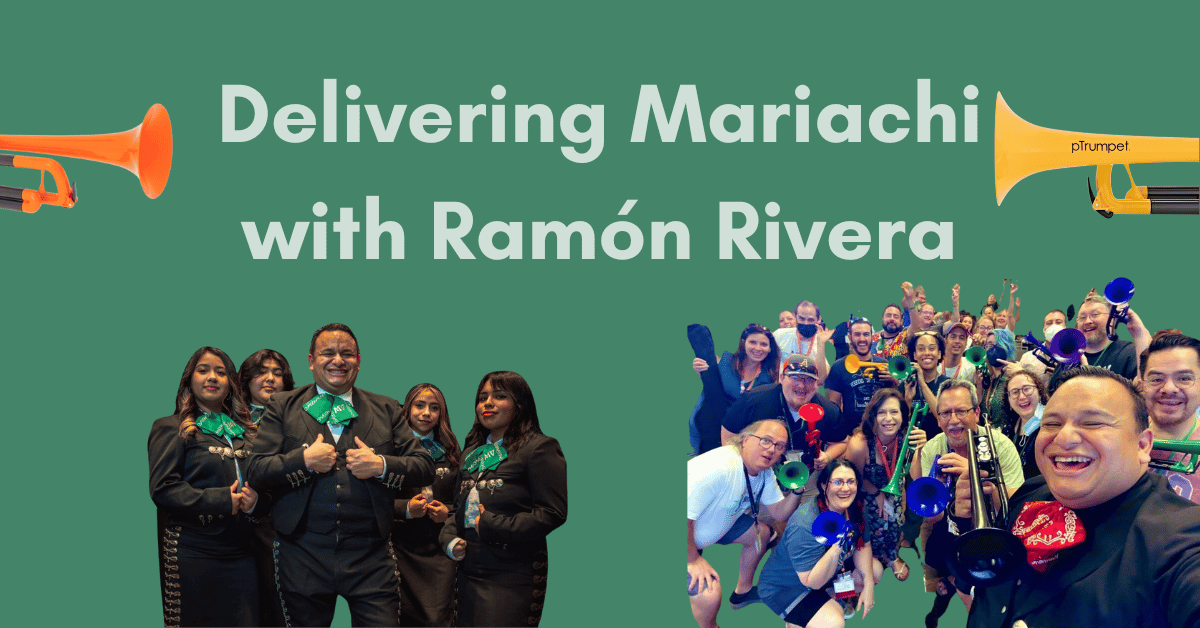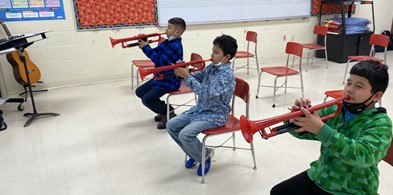Delivering Mariachi with Ramón Rivera
October 4th, 2024
5 min read

When it comes to making mariachi accessible and engaging for students and educators, Ramón Rivera is a name you can’t ignore. As a music educator with 25 years of experience, Ramón has been traveling across the United States, inspiring teachers and students to embrace mariachi in their music programs. Ramón knows that music is for everyone, and it’s our job as educators to create opportunities for all students to feel connected to their school and culture through music.
With mariachi music experiencing a surge of interest and Hispanic Heritage Month taking place between September 15th and October 15th, now is the perfect time to sprinkle some mariachi music into your lessons. But what if you've never taught mariachi?
I recently caught up with Ramón Rivera to discuss the unique training that he has delivered to teachers with pBone Music. As you'll discover in our interview, mariachi can be for everyone. If you’re an educator, particularly a music teacher, looking to introduce mariachi into your program, this conversation is a must-read (and a must-watch if you check out or full video interview).

Making Mariachi Music Accessible
Ramón’s approach to music education is about accessibility. He works to ensure that every student, regardless of their background or their economic situation, has the opportunity to learn and play an instrument. The key is to start with simple tools like pInstruments. And you can't start a mariachi program without a trumpet...
“I worked with a school that had sign-ups for 17 trumpets. And you know, a school budget to buy 17 trumpets is a lot of money - there’s no way you can give each student a brass instrument. [...] But with the pTrumpet, we were able to get each student a trumpet in their hands. No sharing.”
Accessibility is crucial, especially when traditional brass instruments for younger students can be expensive to repair and service. pTrumpet, and other classroom favorites like pBone and pBuzz, offer a more affordable solution, allowing students to learn on real instruments that are more affordable and durable.
Easing Educator Anxiety: Everyone Can Teach Mariachi!
One of the main challenges all teachers face is the fear of the unknown. Many music educators have no experience with mariachi music: Ramón sees this regularly in his sessions and understands the hesitation.
"People are afraid because they are like, 'I don't speak Spanish. I don't look like you. I'm not Latino', but our job - and I think I said this in last year's podcast - is that we teach from Mariachi to Mozart. [...] If you're not doing all of that, then your your your kids are missing out. And that's why I preach the good word."
In his workshops, Ramón introduces fun, practical methods for teaching brass instruments, even to non-music teachers. His buzzing technique, involving paper airplanes, teaches students the essential skill of making sound on a brass mouthpiece before moving on to instruments.
"I did a workshop in Seattle about two weeks ago for non-music educators, and they work for nonprofits [...] and I was able to teach them how to buzz.
They weren't music teachers. They were nonprofits and they were able to play the pBuzz. So I told them. I said, 'Look, if I could teach you how to buzz and play the pBuzz, your community could do that, too.'"

Why Teach Mariachi? Cultural Representation Matters
In schools across the country, particularly those with growing Latino populations, music educators have a golden opportunity to make students feel seen and heard by incorporating mariachi into their curriculum. Ramón stresses the importance of teaching music that reflects the community you serve...
“When I teach, I look at, look at my demographics, the school that I teach at Mount Vernon High School, I have 60% Latino students. So am I going to be teaching Sousa or the British marches? Probably not. I will be teaching what our community wants to hear and they love Mariachi. It's a way to connect them to our school.”
For many students, mariachi music is a direct link to their heritage. By teaching mariachi, teachers can show students that their culture is respected and valued in the classroom.
Simple Ways to Get Started with Mariachi
Ramón emphasizes that starting a mariachi program doesn’t have to be overwhelming. He suggests educators take small, manageable steps, using the resources that are already available. pBone Music has developed a library of free resources, including sheet music, instructional videos, and even simple songs to get beginners started.
"We have simple 8-measure songs that are on our website, and that are on our blogs where teachers could start simple songs. We also use the BrassTabs. BrassTabs are really cool because they show you the high and the low, and then they also show you the fingerings. So if you want to start Mariachi, look at our free resources on our website."
Ramón’s workshops have helped schools all over the country launch successful mariachi programs. In Birmingham, Alabama, for example, a teacher who started with 15 students now has 88 students signed up for mariachi, thanks to the enthusiasm generated by these workshops.
One tool that Ramón suggests educators utilize is the power of community. Music is not just about teaching students; it’s about engaging the entire community, from parents to local musicians. And this wider support might just help turbo-charge your program:
"Reach out to your community, because you have a lot of musicians that are not part of your music program that play mariachi or play other kind of styles of Latino music, and they can help.
I worked with an Alabama school, and they had a Spanish teacher who was helping them through the whole process. Because the Spanish teacher was like, “I studied the lyrics, I knew what it was about.” So there are tons of resources at your school that you may not know that you can use."
Music is also a powerful recruitment tool. By showcasing mariachi performances at school events, open houses, or parent nights, educators can inspire more students and their families to get involved.
"Pinson Valley High School showed my Mariachi Monday video to the entire school. So they did it as part of Hispanic Heritage Month like, 'This is Mariachi'. So I think that's why they got 88 sign-ups for it, because everybody in a science class, in English class, in biology class, and in a PE class: they had to watch the one-minute video, and I think that that was great, that the school was all in.
Why Every Teacher Should Embrace Mariachi
Ramón’s message to teachers is clear: you don’t have to be Latino or speak Spanish to teach mariachi. You just have to care about your students and be willing to learn.
For teachers who want to explore mariachi but feel overwhelmed, Ramón has this advice:
"I know you're a lot of teachers are set in their ways of teaching, but I think a lot of them are going to take that step and try these new things and how to reach their Latino community.
It's just so amazing that teachers are now getting excited to teach Hispanic Heritage Month because they're just so bombarded at the beginning of the year with grades and new things, and getting their room set up. But I think now, having these resources, it's a game changer for a lot of our teachers."
Check out the full interview with Ramón:
With Hispanic Heritage Month just around the corner, now is the perfect time to introduce mariachi into your music program. Thanks to Ramón’s resources and support from pBone Music, mariachi can be a fixture in your classroom not just for a month, but the entire school year and beyond!
- Want some fun ways to introduce mariachi into your school? Check out the top ten mariachi tunes for a fun starter activity.
- If pTrumpet has piqued your interest, discover why our innovative instrument is such a good fit for a mariachi program.
Adam is the Content Manager at pBone Music. This should mean that he’s the ideal person to write about himself, but he finds boasting in the third person a little awkward. He honed his word wizardry with a degree in English Language and Literature at the University of Leeds. He has since written copy for clients and businesses across the land, from awards to something beginning with “z”. He also spent a number of years as a musician. He has written pop songs and even jingles for kids, performed more first dances at weddings than you could shake a pBuzz at, and once played a gig for a pie company at The Etihad Stadium in Manchester. When he’s not reminiscing about those good old days, you might find Adam enjoying the football (although as an Everton fan, that can be difficult). He also loves spending time with his partner, Jen, and his family and friends, and sincerely hopes they feel the same way.
Topics:
